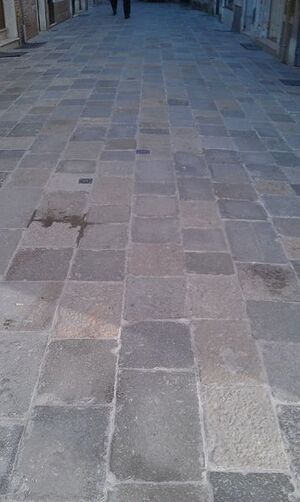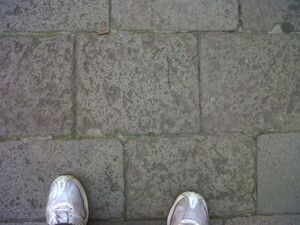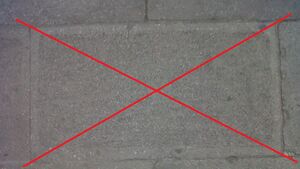Paving Stones

Stones used in Venetian Stone Pavement include both traditional and new Masegni, Salizzone, and even Istria Stone can be seen in some Campo layouts. Masegni are common pavement stones and have been used to pave Venice's streets since 1676.[1] Both types of masegni and salizzone are made from Trachyte, a volcanic stone that is a mixture of erupted and extrusive volcanic rock. The particular Trachyte used in the Venetian Streets is quarried in the Colli Euganei.[2] Trachyte is a compact and durable stone; even as it wears down it remains rough, making it perfect for lining the Streets of Venice.
Stone Dimensions
Before any Masegni are used in the pavement they must first be tested for proportionality by a Dima, if they they do not fit the Venetian standard then the stone will not be used.
Typical dimensions for the three dominant stones used in stone pavements can be seen in the following table.
| Length(cm) | Width (cm) | Height (cm) | |
|---|---|---|---|
| Traditional Masegni | 25-70 | 20-35 | 10-15 |
| New Masegni | 25-70 | 20-35 | 10 |
| Salizzone | 70 | 35 | 10 |
Stone Treatment

There are three different ways a stone can be treated before being used in a street paving.
Texturing
Bocciardatura refers to the process of hammering the surface of a stone with a Bush Hammer in order to roughen up the surface. This provides more grip for pedestrians walking over the stones and also gives the stones a more natural appearance. In the past(18th through early 20th century), bocciardatura was done by hand in a very artful manner. However, in present day Bocciardatura is done using "jackhammer like" machines either at the quarry when the stones are first mined or on site before the stones are laid into the pavement. This is done as a means to save money.[3]
Edging
In order to keep an aged look to match Venice's appearance it's desirable for stones to have a rough edging. To accomplish this, before being laid, stones endure refinatura. This technique refers to edging the stones with a chisel in order to acheive that freshly quarried appearance.

Bordering
Some stones in Venice have a border. This is refereed to as cordolina and is undesirable. Cordolina have been roughened up in the center but have a smooth untouched border. These stones appear out of place when used in the Venetian street pavement, and are now forbidden to be used.
See also
References
Bibliography
NULL